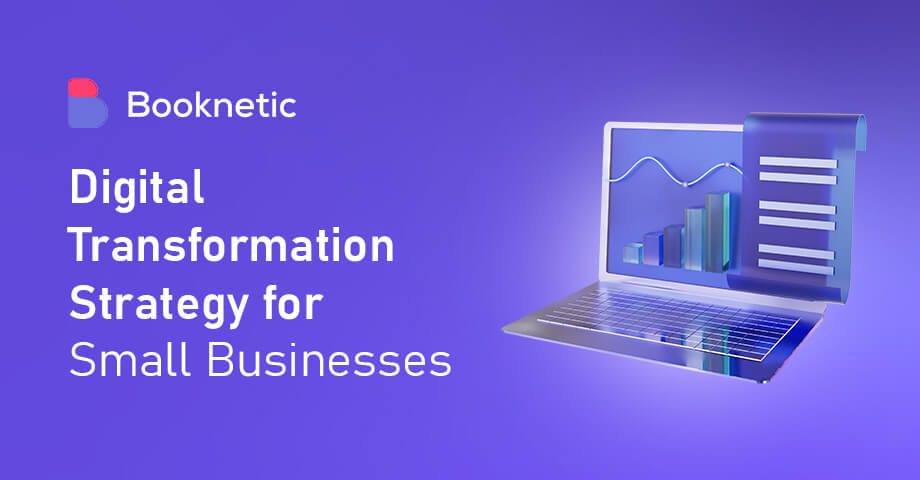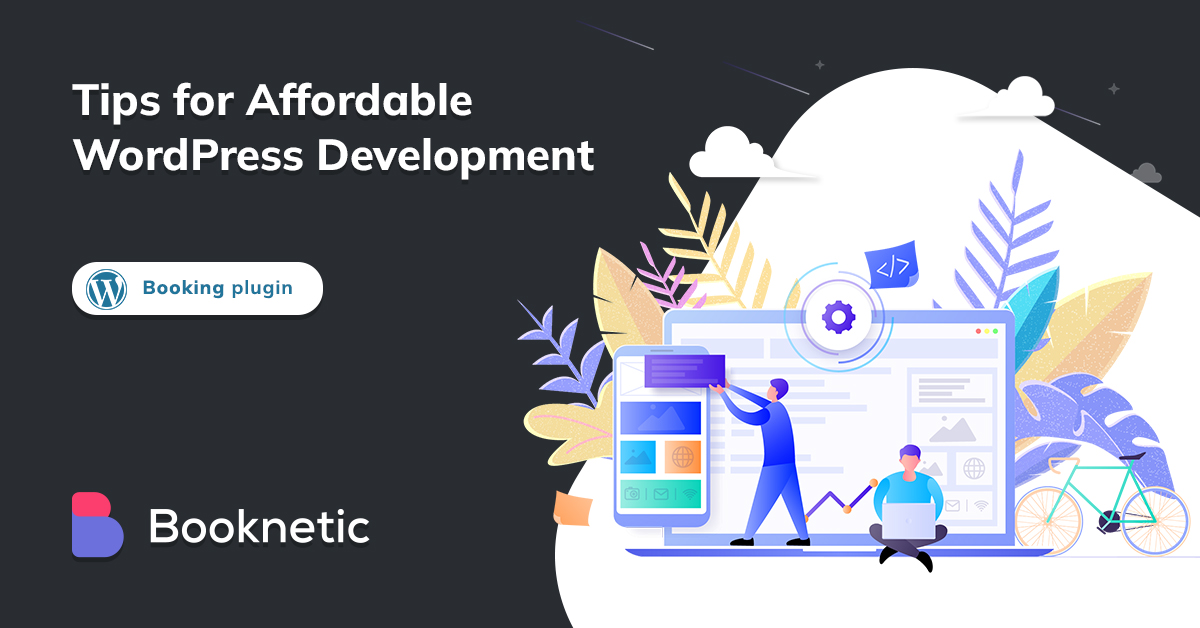[contents-table]
If you're a small business, it's more important than ever to have a digital transformation strategy.
In this blog post, we'll discuss what that means and how you can implement one. Having a strong online presence is essential for small businesses these days – it allows you to reach more customers and compete with bigger businesses.
What is digital transformation?
Digital transformation is the incorporation of digital technologies into an organization's products, processes and strategies.
Which digital technologies are used and why, how they are applied and what is gained from their application differ from company to company.
Each digital transformation project may have a different scope in line with the needs of the company.
For example, if you are operating an accounting firm, your digital transformation could be a complete overhaul of your tools and operations. If you operate a beauty salon, simply introducing an appointment booking could be enough.
It may require examining and re-engineering all aspects of the organization, from supply chains to workflow, from employee skill sets to customer interactions and organizational charts.
Whatever the scope, digital transformation has two main drivers: optimizing the company's workflow and expanding its market.
The difference between digitization, digitalization and digital transformation
Digitization, in simple terms, is turning something physical, like a paper, into a digital format that a computer can read.
Digitalization for a business means using digital tools and data to make tasks easier and more efficient.
Digital Transformation is when a whole business changes how it operates using digital tools, going beyond just digitizing information or using digital processes. It's a holistic change, involving strategy, processes, and culture.
Depth and Scope:
The scope of impact for digitization is narrower, focusing on converting analog information. For digitalization, the scope broadens to changing specific business processes using digital tools.
Digital Transformation has the widest scope, involving complete changes in business operations, culture, and customer experiences.
A real-world example for digitization is scanning a physical book to create an e-book. For digitalization, it's a library implementing an online reservation system.
Digital Transformation would be the library evolving into a digital knowledge hub with online learning resources, virtual discussions, and more.
Impact on Businesses:
The objectives of digitization usually center on efficiency in storing and retrieving data. For Digital Transformation, the objectives are broader: improving customer experiences, fostering innovation, and achieving competitive advantage.
Digitalization might mean employees need to learn new software or tools. In Digital Transformation, they might need to adapt to new roles or even see their roles become obsolete, requiring reskilling or upskilling.
Technological Involvement:
In digitization, technology's role is foundational, turning analog to digital. In digitalization, technology optimizes specific processes. In Digital Transformation, technology is pivotal, driving change across the business.
Scanners and OCR (Optical Character Recognition) tools are often linked with digitization. Some common examples include Google Lens and Image to Text Converter . In contrast, Digital Transformation might involve AI, big data, or IoT.
The three concepts will likely continue evolving with technological advancements. As businesses mature, distinctions between them might blur, especially as companies that have undergone digital transformation might continually digitize and digitalize new processes.
Yet, understanding their nuances will always be crucial for strategic implementation.
8 Step Digital Transformation Strategy for Small Businesses
Businesses need to keep up with digital literacy to stay competitive. Digital transformation starts with employees, so they must be trained on new technologies.
While determining digital transformation strategies in enterprises, besides technology-oriented investment plans, studies should be carried out to instill a digitalization culture in employees, so that the most efficiency can be obtained from digitalization efforts.
SMEs must have a high-performance website compatible with all devices, suitable for user experience, considering today's customer masses in their digitalization processes. In this way, the potential and speed of reaching customers can be increased. Sales and marketing channels can therefore develop economically.
1. Assign tasks and responsibilities to your staff
We know it is quite difficult to create dedicated teams to carry out the small business digital transformation project in a small company.
That's why it's extremely important to assign a member of your team a project management role, or at least temporarily hire a specialist. That’s why agile teams have roles such as product owner and SCRUM master.
Make sure that all relevant stakeholders are involved and understand the meaning of this transformation. Because not only people responsible for information technologies, but also managers and decision-makers should be involved in the process.
Working without sharing information can hinder innovation and your rapid focus. According to Harvard Business Review , information disbalance and communication negatively impact half of the workforce.
Therefore, involving as many people as possible in the process will ensure that your small business's digital transformation strategy meets the needs of the entire business from the start.
2. Do not underestimate the power of research
The second important step you need to create a digital-first strategy is to research what your customers expect from a supplier.
Starting out without research will mean risking any investment you've made in integrating new technologies into your workflows.
A detailed research process, on the other hand, provides valuable information, such as what features your potential customers are looking for in the businesses they will work with and what factors your current customers' loyalty to a manufacturer depends on.
So start with what you want the impact to look like. Go into as much detail as possible. Lay out exactly:
What should change
How they should change
What the end process should look like
How each employee should perform
And how much variation will you tolerance
Then, start researching and envisioning how you want the process to be carried out and how you want the end process to look.
3. Follow an effective purchasing policy
While drawing their digital roadmaps, businesses that prefer to outsource services at stages such as planning, research, technical support and integration may encounter pauses at some points.
It is normal for such pauses to occur from time to time when it comes to large-scale processes such as the digitization process.
For this reason, when deciding on the external resources that will support you in creating an effective digital transformation policy and the budgets to be allocated to them, you should consider all of the criteria such as experience, expert opinions, trust and consensus within a reasonable balance.
Calculate for at least 30% overhead costs to ensure your business has enough to cover any potential issue that might come up. Also, give yourself 15-20% more headroom to communicate with outsourcers and fix inevitable problems.
Here are some additional tips for following an effective purchasing policy:
Do your research and compare prices from multiple vendors.
Get everything in writing, including the scope of work, the timeline, and the payment terms.
Make sure you have a clear understanding of the vendor's return policy and warranty.
Be prepared to walk away from a deal if it doesn't meet your needs.
Monitor the progress of the project closely and be prepared to make changes as needed.
Get everything in writing when the project is complete, including the final product, the payment terms, and the warranty.
4. Master the company culture
After taking the necessary steps about your competitors, short and long-term goals, current and potential customers, and purchasing policies, what you need to do is to analyze your company culture in depth.
No matter how good your plan is, if your innovation doesn't fit your company culture, it will be hard to implement. And your staff will resist to this change.
Even the most effective digital transformation strategy is doomed to fail if it does not get the support of the managers who will transfer it to their employees and the employees who will implement it.
So make sure you have open communication from the beginning to till the end.
5. Get employee support for change
The first step is to make sure you have the support of your employees for any change you want to implement. They are the lifeblood of small businesses. It is also the key to successful digital transformation .
If they are not on board, it will be much more difficult to make progress.
Try to get them invested in the process by explaining how these changes will benefit them and the company as a whole.
You should also seek their feedback and ideas throughout the transformation process.
That's why it's so important for small business owners to get support from employees for any digital transformation initiative.
Here is how to announce it to your staff to guarantee minimal damage and even potential support for the initiative:
Choose the Right Time and Setting : Choose a time when your staff is least stressed and can be attentive. A staff meeting or a specially convened gathering would be appropriate.Start with the 'Why' : Before explaining what will change, explain why the change is happening. Emphasize the benefits to the company, the team, and importantly, to individual employees.Be Transparent : While you want to soothe anxieties, it's essential to be transparent. If you don't have answers to certain questions, it's okay to admit it and commit to finding those answers.Highlight the Positives : Emphasize the potential benefits, such as efficiency, growth opportunities, and the possibility of exploring new tools and skillsets.Offer Reassurance : Guarantee employees that their value isn't determined by the tools they use. Reinforce that the digital transformation aims to equip them with better tools to make their jobs easier and more efficient.Training and Support : Promise and deliver continuous training and support. Show everyone that they will be taught how to navigate and utilize new tools or processes.Open Floor for Questions : After your announcement, allow ample time for questions. This will give employees a chance to voice their concerns and gain clarity.Invite Feedback : Let them know that their feedback is invaluable. Encourage them to share their thoughts, feelings, and ideas about the transition. Consider setting up a suggestion box or an anonymous digital form.Appoint Digital Transformation Ambassadors : Identify and train a few staff members to be the 'go-to' people for any queries related to the transformation. They can provide peer support and help reduce the burden on the training team.Regular Updates : Keep the communication lines open. Regularly update the staff on the progress of the transformation, any changes to the plan, or any new tools that will be introduced.Acknowledge Anxieties : It's okay to acknowledge that change can be daunting. By recognizing their feelings, you're showing empathy, which can help reduce some of the anxiety.Personalize the Approach : If feasible, meet with smaller teams or departments to discuss how the transformation will impact their specific roles. This tailored approach can help in addressing more specific concerns.Set and Recognize Milestones : Create milestones that will be achieved during the transformation process. It can be an effective way to keep morale high and show appreciation for everyone's efforts.
6. Develop performance tracking and verification methods
Digital transformation can mean different things to different businesses, but one common goal is improving performance. To do this, you'll need to establish metrics and KPIs to track progress against your objectives.
You'll also need a way to verify that the improvements are real and not just illusions created by changes in how you're measuring progress.
This can be a challenge for small businesses, which often don't have the same resources as larger companies. But there are ways to overcome these obstacles.
One is to partner with other small businesses that are going through similar transformations. This way, you can share resources and best practices.
Another is implementing a smaller model of corporate performance tracking methodologies in your team.
Define Clear Objectives : Start by setting clear, measurable goals for your team. Whether it's sales targets, project completion dates, or client satisfaction rates, know what you want to achieve.Simple Tracking Tools : Use tools like spreadsheets, Trello, or Asana. They're user-friendly and sufficient for smaller teams.Regular Check-ins : Schedule weekly or bi-weekly check-ins with your team to discuss progress, challenges, and solutions.Feedback Mechanism : Create a simple process for team members to provide feedback. This could be a shared document, a suggestion box, or a dedicated time in meetings.KPIs (Key Performance Indicators) : Identify a few critical indicators that align with your objectives. Track these meticulously. For example, if you're tracking sales, a KPI could be 'Number of Client Calls.'Visual Dashboards : Use tools like Google Data Studio or even PowerPoint to create visual dashboards. They can provide at-a-glance insights into performance.Encourage Self-tracking : Train team members to track their performance. It fosters responsibility and self-awareness.
7. Teach employees about new systems
One of the best ways to ensure a successful digital transformation is to teach your employees about the new systems.
By providing training and support, you can help them feel comfortable using the new technology. Additionally, keep communication open so they can provide feedback about their experience.
With proper planning and execution, your digital transformation strategy will succeed.
First, you need to plan the digital skills your staff would need. Do they need to learn a completely new software that is unfamiliar to them? Or do they need to learn a new Excel function? Make sure you first find out the current digital literacy level of employees and find out how much they need to learn.
Secondly, define training modules and start creating them. A good rule of thumb is to make them 70% hands-on exercises, 20% group tasks, and 10% learning materials.
Thirdly, decide on training durations and schedules. Choose a low time to optimize attendance and keep the lessons between 30-45 minutes. Change the duration based on the training modules. For hands-on exercises and communication lessons, make them over an hour and keep them entirely practical with three 5-minute breaks.
8. Regularly check the performance of systems in the focus of your business tasks
This is the only way to ensure that you are really reaping the benefits of digital transformation and not just wasting time and money.
Checking performance means looking at things like response times, system availability, data quality, etc. You should also keep an eye on changes in user behavior. If people are suddenly doing things differently, it might indicate that something isn’t working as it should.
Keep track of your performance of staff and make adjustments along the way. 6 months after completing the original training, create refresher training sessions for an hour to cover the important topics you mentioned.
Of course, you can’t do all of this yourself. You will need to rely on tools and services to help you monitor performance and get insights into how your systems are being used.
But don’t worry, there are plenty of options out there – both free and paid – that can fit any budget.
Conclusion
Want to know more about digital transformation for your small business?
Check out our website for more articles on the subject. We have a range of resources that can help you figure out what changes you need to make and how to make them. Our team is also available to answer any questions or provide advice, so don’t hesitate to get in touch if you want some help getting started on your own small business digital transformation journey.




















